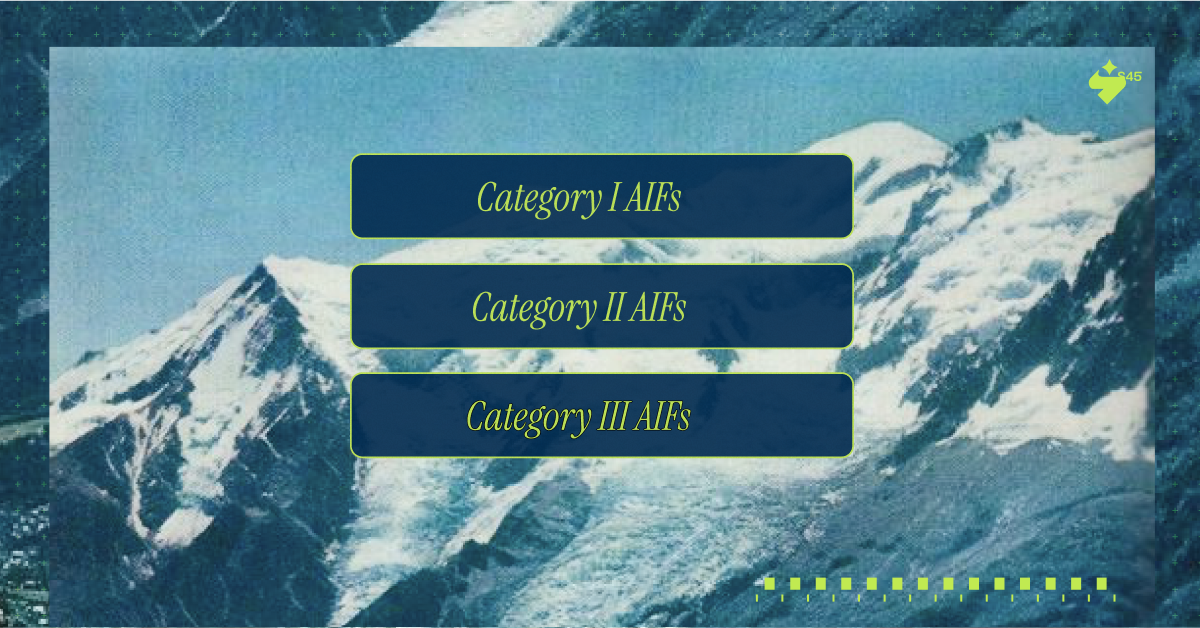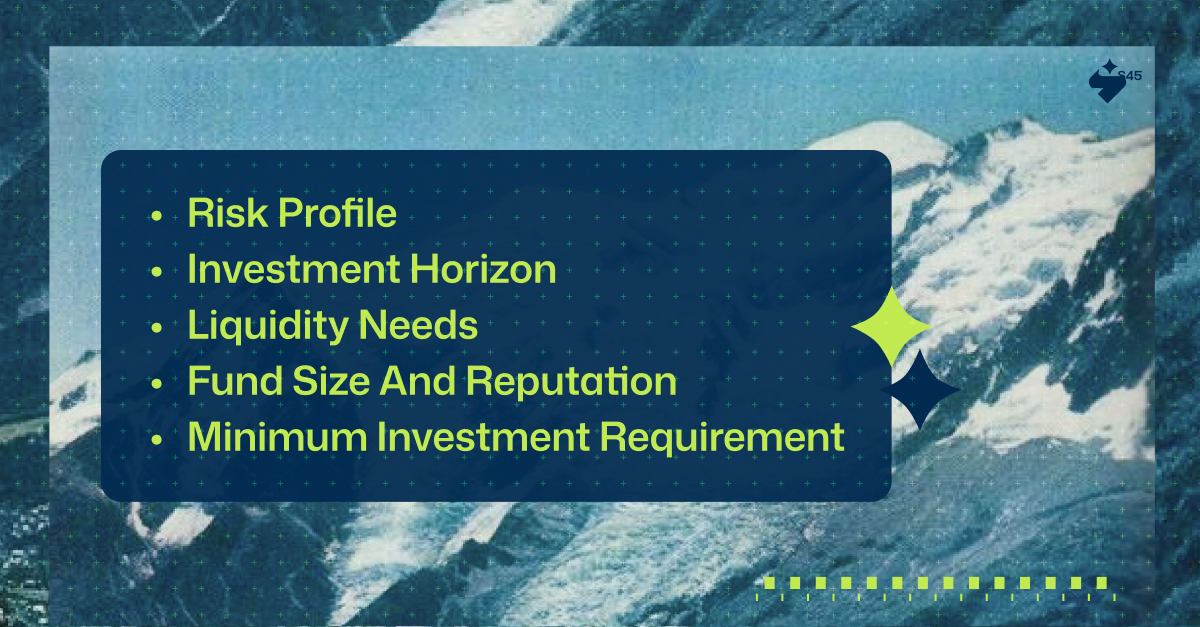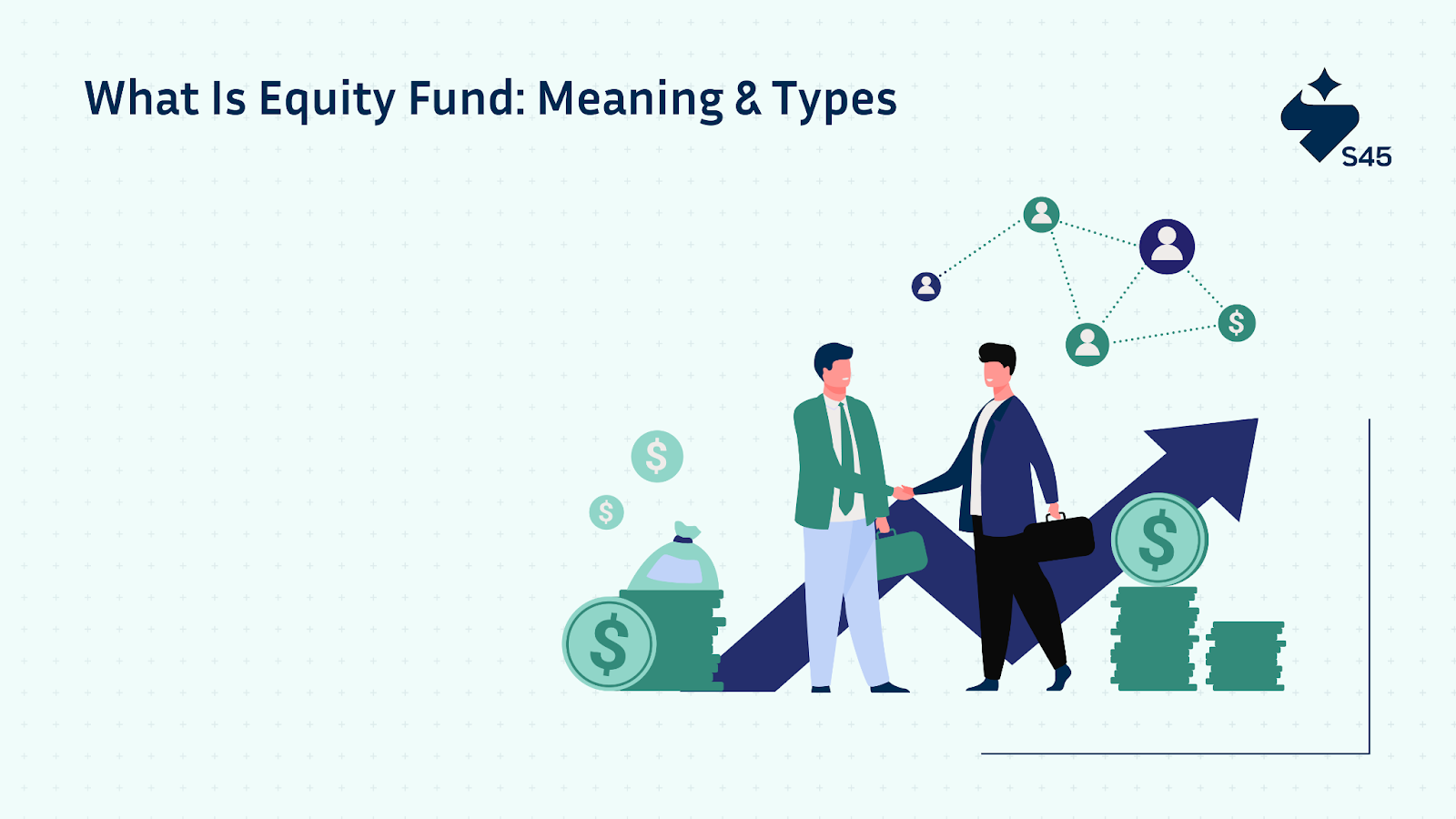
Key Insights:
- AIF Categories: Category I focuses on sustainable, long-term growth; Category II balances moderate risk with returns; Category III targets high-risk, high-reward opportunities with active strategies.
- Investment Focus: AIFs invest across equity, debt, real assets, and derivatives to diversify portfolios and manage risks while pursuing targeted returns specific to each category.
- Risk and Return: Category I emphasizes lower risk and steady growth; Category II offers balanced risk and return; Category III involves higher risk for potentially larger returns.
- Fund Selection: Choosing the right AIF depends on understanding risk tolerance, investment horizon, and liquidity needs to align with business goals and financial objectives.
Your investment advisor mentions a "Category II AIF," but you're left wondering what makes it different from other fund types. Most investors get confused by the three AIF categories, treating them as interchangeable investment options.
This confusion costs money and leads to poor investment decisions. Total commitments for AIFs reached Rs 14.2 trillion as of June 2025, marking a 20% year-on-year jump and 5% sequential growth, proving these funds matter more than ever.
Each category follows distinct regulatory frameworks and serves different investor needs. This article helps break down these categories, giving you a clearer view of how they can fit into your investment strategy.
Categories of Alternative Investment Funds (AIFs)

AIFs in India are divided into three categories by SEBI, each catering to different investment strategies and risk profiles. Understanding these categories is key to selecting the right fund for your investment goals.
Category I AIFs
Category I funds receive regulatory support because they invest in sectors the government considers economically valuable. Think startup funding, infrastructure development, and social impact ventures.
These funds focus on early-stage ventures, social ventures, SMEs, infrastructure, or other sectors that the Government or regulators consider as socially or economically desirable.
Key Features:
- Invest in sectors like infrastructure, social causes, or early-stage businesses.
- Generally attracts long-term investors looking for sustainable growth.
- Lower liquidity compared to other categories, with long lock-in periods.
- Usually benefit from certain tax incentives, especially if they focus on social and economic development.
- Typically structured as venture capital or social venture funds.
- Greater focus on impact investing, often targeting underserved or emerging industries.
- Risk-adjusted returns may be lower due to the early-stage nature of investments.
As Category I AIFs focus on early-stage ventures and sustainable growth, S45 Club is uniquely positioned to help MSME founders seize these opportunities. With a blend of capital and expertise, S45 Club supports entrepreneurs in scaling their businesses while prioritizing long-term impact. Together, we can turn innovative ideas into lasting legacies.
Category II AIFs
Category II funds include private equity and debt funds. These funds don't have a specific sectoral focus but instead aim for higher returns through a mix of equity and debt investments.
They offer a balance between risk and return, making them attractive to investors who want to diversify their portfolios but are not seeking overly high-risk opportunities.
Key Features:
- Target growth-stage businesses, including those in private equity or debt markets.
- Attract medium- to long-term capital with a moderate risk-return profile.
- Typically have better liquidity than Category I funds due to a more established investor base.
- Focus on generating high returns by investing in stable or emerging businesses.
- Offer moderate risk levels, appealing to investors who want consistent returns over time.
- Popular among institutional investors and those seeking diversified portfolios.
Category III AIFs
These funds are the highest-risk category and include hedge funds, arbitrage funds, and funds focusing on short-term market movements.
Category III funds aim for significant returns, often through active trading strategies like short selling, derivatives, and market arbitrage.
They’re generally suited for high-net-worth individuals who are willing to accept substantial risk for potentially high rewards.
Key Features:
- Focus on high-risk strategies like hedge fund investments and arbitrage.
- Investors can see high returns, but volatility is common.
- Greater liquidity than Category I and II funds due to active market participation and more frequent trades.
- High fees and expenses due to the sophisticated strategies employed.
- Suitable for investors looking for short-term market opportunities or arbitrage opportunities.
- Portfolio diversification can be achieved through both long and short positions, offering potential upside in different market conditions.
Now that we’ve covered the three categories of AIFs, let’s take a closer look at the kinds of investments each one focuses on.
We’ll break down the specific strategies and instruments they use, so you can better understand how these funds manage risk and work towards delivering returns.
This will give you a clearer picture of how different AIFs could fit into your investment plan.
Investment Types Across Categories
While each category has its distinct focus, many AIFs invest across different asset classes to maximize returns:
- Equity Investments: A large portion of AIFs, especially Category I and II, invest in equity markets, offering access to high-growth potential companies.
- Debt Instruments: Category II AIFs commonly use debt instruments, aiming for stable returns while managing risk.
- Real Assets: A growing trend in Category II and III, real estate and infrastructure investments offer solid diversification and serve as a hedge against inflation.
- Structured Products and Derivatives: More common in Category III, these complex investments allow AIFs to target short-term gains and manage high risks.
As AIFs diversify across equity, debt, and real assets to maximize returns, S45 Club uses its deep industry insights to support MSME founders.
With a better understanding of the investment strategies used across the different AIF categories, it’s now time to turn our attention to the tax implications. Taxation is an important factor to consider when investing in AIFs, as it directly affects the returns you’ll receive.
In the next section, we'll break down how AIFs are taxed and what it means for you as an investor.
Taxation of AIFs
The tax structure for AIFs in India is largely shaped by their category and the nature of the investments they make.
Typically, AIFs are considered "pass-through" entities. This means the income generated by the fund is passed directly to the investors, who then pay taxes based on their individual tax bracket.
While this provides certain tax advantages, it also requires careful consideration of how the fund operates.
Taxation Rules for Each Category of AIFs:
- Category I AIFs:
These funds often focus on social causes, startups, or other sectors considered important for economic development. As such, they may be eligible for specific tax exemptions or incentives, designed to encourage investment in sectors like infrastructure or social welfare.
For instance, Category I AIFs that invest in startups may receive exemptions under the Income Tax Act, benefiting both the fund and the investors by lowering the tax burden.
This makes Category I funds attractive for long-term investors looking to contribute to social impact while enjoying potential tax breaks.
- Category II AIFs:
Funds in this category, such as private equity and debt funds, usually face more straightforward tax treatment. The income generated from these funds is passed on to investors and taxed at their individual tax rates.
Category II AIFs may also benefit from capital gains tax treatment, depending on the holding period of the investments. However, unlike Category I, they do not typically qualify for special tax exemptions.
For investors, understanding the specific capital gains rates (both long-term or short-term) will be crucial to understanding the net return after tax.
- Category III AIFs:
These funds, which include hedge funds and arbitrage funds, are often the most complex in terms of tax treatment. Since these funds actively trade and engage in strategies like derivatives and short-selling, their returns can be more volatile.
The tax implications here depend on the nature of the returns, whether they’re capital gains or income from trading. Depending on how long the assets are held, short-term gains could be taxed at a higher rate compared to long-term gains.
Investors should be aware that these funds might also have higher fees and expenses, which can further affect their taxable returns.
Additional Notes
In addition to understanding the tax benefits or liabilities that come with each category of AIF, it’s also crucial to factor in the structure of the fund.
For example, in certain cases, AIFs might distribute income regularly (like dividends or interest payments), while others may offer returns only when the investments are sold or matured.
This income distribution and its corresponding tax treatment vary based on how the fund is structured, so it’s important to carefully review the fund's offering documents and consult with tax professionals.
Now that we've tackled the tax side of things, let's get into the practical aspects of choosing an AIF that’s right for you.
Considerations Before Investing in Alternative Investment Funds
Picking the wrong AIF category can lock up your money in unsuitable investments for years. Each category serves different investor types, and mismatching your profile with the fund structure creates unnecessary risks and suboptimal returns.

There are several factors to consider before you commit your capital.
1. Risk Profile
Your risk appetite should be the starting point. AIFs cater to different types of risk tolerance. If you prefer lower-risk options with steady, long-term growth, Category I funds are a good fit.
These funds typically focus on early-stage businesses or sectors with growth potential, offering stability over time.
On the other hand, Category III funds, which include hedge funds and arbitrage strategies, are high-risk, high-reward ventures, often relying on short-term market movements.
If you're comfortable with volatility and looking for quicker returns, these funds might be more suitable.
2. Investment Horizon
Your investment timeline is also a key consideration. Category I AIFs are ideal for long-term investors who don’t mind waiting for their capital to appreciate over an extended period.
These funds are usually locked in for a few years as they invest in startups or projects that take time to mature.
Category II AIFs tend to cater to investors with medium-term horizons, while Category III AIFs, with their focus on more active strategies, are better for those who want quicker results. If you’re looking to generate returns within a few years, Category III could be a better match.
3. Liquidity Needs
Liquidity is an essential factor in the decision-making process. If you anticipate needing access to your capital sooner, Category III funds are likely a better fit, as they offer more frequent trading opportunities and shorter investment durations.
Category I and II funds, in contrast, often have longer lock-in periods and lower liquidity due to their focus on longer-term investments like private equity or real estate.
It’s important to align your liquidity needs with the fund’s investment horizon to avoid being stuck with your capital when you need it.
4. Fund Size and Reputation
The size and reputation of the AIF matter in terms of stability and trust. Larger funds tend to have a more diversified portfolio, which can reduce risk, and they may offer a greater degree of security due to their established track record.
However, these funds often come with higher fees, which can eat into your returns. Smaller funds, while potentially offering high growth opportunities and more flexibility, also come with a higher risk.
The track record and credibility of the fund manager also play an instrumental role - funds managed by experienced professionals with a solid reputation may offer better risk management.
5. Minimum Investment Requirement
AIFs usually have a minimum investment threshold of ₹1 crore. This higher barrier to entry means that AIFs are typically suited for high-net-worth individuals (HNIs) or institutional investors. Before committing, ensure that you meet the minimum investment requirement and that the fund fits with your overall capital allocation strategy.
How S45 Can Help You Choose the Right Fund and Investors
At S45 Club, we focus on guiding MSME founders through the process of selecting the right fund and investors, ensuring the best fit for your business's unique needs.
With our deep understanding of sustainable growth, innovation, and long-term success, we help you make informed decisions that set your business up for the future.
Here’s how we can support you:
- Understanding Your Business Needs: We assess your company’s goals, market positioning, and growth potential to match you with the most appropriate fund and investors.
- Capital and Expertise: We provide the right combination of financial support and industry knowledge, ensuring you have the tools and guidance needed for effective scaling.
- Focus on Sustainable Growth: Our approach emphasizes steady, long-term growth strategies, helping you build a business that stands the test of time.
- Building Strong Investor Relationships: We connect you with investors who align with your business values, fostering collaboration and shared success.
- Beyond Funding: Our support goes beyond just investment—we offer insights and mentorship to help your business innovate, scale, and thrive.
Connect with S45 Club today to access the capital and expertise that will take your business further.
Conclusion
Each AIF category offers distinct investment strategies, each with its own set of risks and rewards. If you're seeking steady, long-term growth with Category I, understanding these categories is essential for making informed investment decisions.
For a balanced approach in Category II, it's important to evaluate the potential risks and rewards. If you're aiming for high-risk, high-reward strategies with Category III, carefully consider the volatility involved before proceeding.
A carefully selected AIF can enhance your portfolio, providing opportunities that go beyond traditional assets, helping you diversify and maximize returns.
Now, with this knowledge, you can take the next step in growing your business. S45 Club is committed to helping MSME founders navigate this process with ease. We offer both capital and expertise, ensuring that every decision is backed by sound advice and sustainable strategies.
Our focus on long-term growth, collaboration, and building lasting businesses means that we’re not just investors, we’re partners in your journey. Join our community today to access the tools, resources, and network that will help you scale and succeed.


